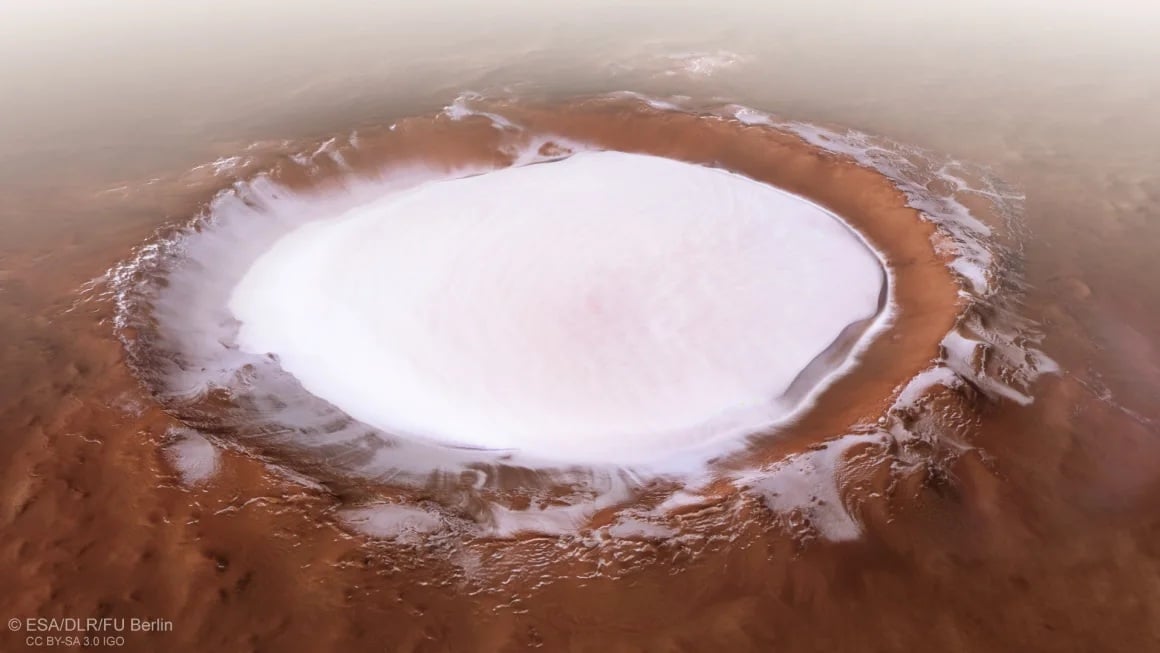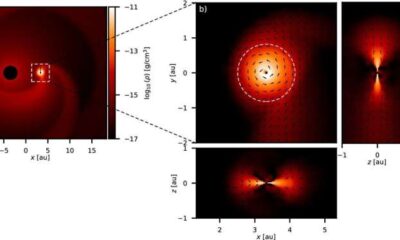Science
New Research Reveals Mars’ Ice Deposits Chronicle Planet’s History

New research indicates that ice deposits within craters on Mars provide crucial insights into the planet’s climatic history. A team of researchers from various institutions, led by Trishit Ruj of Okayama University, has discovered that these ice layers are similar to Earth’s glaciers, recording significant climatic cycles over hundreds of millions of years. Their findings suggest that Mars underwent multiple ice ages, shedding light on the gradual transition from a warmer, wetter planet to its current cold, arid state.
The study, published in the journal Geology, emphasizes the importance of examining Martian craters located between 20°N and 45°N latitude. Using high-resolution images from NASA’s Mars Reconnaissance Orbiter (MRO), the researchers identified glacial landforms, including ridges and maze-like pit formations, indicative of past glaciation. These formations consistently show ice accumulation in shadowed regions, particularly on the southwestern walls of the craters.
Understanding Mars’ climactic changes is critical. The research reveals that fluctuations in the planet’s axial tilt, or obliquity, have influenced its climate. Similar to Earth, Mars’ axial tilt, approximately 25 degrees, leads to varying conditions that result in glaciation and subsequent thawing periods. Over time, these cycles have contributed to a steady decline in ice deposits, indicating a gradual loss of water resources.
Dr. Ruj stated, “Like Earth, these shifts in Mars’ climate were caused by changes in the planet’s axial tilt, which is similarly inclined as Earth’s.” This dynamic environment highlights how Mars dried out during the Amazonian period, which spans from approximately 640 million to 98 million years ago.
The implications of this research extend beyond planetary science. As future crewed missions to Mars aim to utilize local resources for survival—such as water ice for growing food and generating oxygen—understanding the distribution and history of these ice deposits becomes vital. The need for in-situ resource utilization (ISRU) is paramount, especially given the lengthy travel time of six to nine months from Earth to Mars.
Furthermore, the techniques applied to study Martian ice may also benefit Earth’s climate research. Rising global temperatures are leading to severe changes, including the shrinking of ice caps and increased droughts. The same imaging and modeling methods used for Mars can help monitor changes in glaciers, permafrost, and hidden water reserves on Earth.
Dr. Hasegawa from Kochi University remarked, “Mars serves as a natural laboratory for understanding how ice behaves over vast timescales. The insights we gain here can sharpen our understanding of climate processes on Earth as well.”
This groundbreaking research not only enhances our understanding of Mars’ geological history but also emphasizes the potential for cross-applications in addressing climate challenges on our own planet. As scientists continue to explore these icy deposits, they unravel the complex narrative of Mars and its evolution, offering lessons that may be crucial for humanity’s future both on Earth and in space.
-

 Science2 months ago
Science2 months agoOhio State Study Uncovers Brain Connectivity and Function Links
-

 Politics2 months ago
Politics2 months agoHamas Chief Stresses Disarmament Tied to Occupation’s End
-

 Science1 month ago
Science1 month agoUniversity of Hawaiʻi Joins $25.6M AI Project for Disaster Monitoring
-

 Science4 weeks ago
Science4 weeks agoALMA Discovers Companion Orbiting Giant Star π 1 Gruis
-

 Entertainment2 months ago
Entertainment2 months agoMegan Thee Stallion Exposes Alleged Online Attack by Bots
-

 Science2 months ago
Science2 months agoResearchers Challenge 200-Year-Old Physics Principle with Atomic Engines
-

 Entertainment2 months ago
Entertainment2 months agoPaloma Elsesser Shines at LA Event with Iconic Slicked-Back Bun
-

 World1 month ago
World1 month agoFDA Unveils Plan to Cut Drug Prices and Boost Biosimilars
-

 Business2 months ago
Business2 months agoMotley Fool Wealth Management Reduces Medtronic Holdings by 14.7%
-

 Science2 months ago
Science2 months agoInnovator Captures Light at 2 Billion Frames Per Second
-

 Top Stories2 months ago
Top Stories2 months agoFederal Agents Detain Driver in Addison; Protests Erupt Immediately
-

 Entertainment1 month ago
Entertainment1 month agoBeloved Artist and Community Leader Gloria Rosencrants Passes Away









